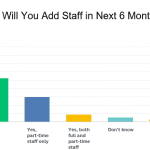
When Society of American Florists members from around the country and across segments convened virtually Sept. 30 for the association’s annual meeting, they shared some of their toughest challenges (finding and keeping employees, supply chain disruptions), and the opportunities they’re capitalizing on now to grow stronger this fall and into the new year (hello, double- and triple digit online sales growth). “We find ourselves in a historic fork in the road,” said SAF President Chris Drummond, AAF, PFCI. “We can dwell on our struggles and start a slow recovery, or we can choose to take the high road and focus on the positives that have come out of this virus and use them to our advantage.”
The meeting, which included a business session focused on reviewing SAF’s financial position and the election of new board of directors members, was an opportunity for association members to share common concerns, hear new perspectives, crowdsource possible solutions and find inspiration to end 2020 on a strong note during a Trends and Challenges discussion. That portion of the event consisted of topline reviews of the key issues tackled by SAF’s volunteer-led Growers, Wholesalers and Retailers Councils, which met virtually earlier in September, followed by “breakout sessions” (private Zoom meetings with a dozen or so members) for participants to discuss these timely topics in more detail before reconvening for a full-group recap.
“The meeting itself, along with those breakout sessions and roundtable discussions, really represent the best of the best in our industry,” said Kate Penn, SAF’s CEO. “Our industry is so entrepreneurial, so forward-thinking, and when we have the chance to come together in this way for some dedicated sharing and collaboration, it paves the way for new opportunities in the future, for all of us.”
Here are a few takeaways from the meeting’s Trends and Challenges Discussion:
Labor is a critical issue in the industry.
Labor has been an ongoing challenge for all segments of the industry for many years. Growers rely heavily on the H-2A visa program to find workers and deal with regulations that change frequently. Many wholesalers struggle to compete with Amazon, which has distribution centers opening all over the country and offers covetable benefits. Many retail employees are reaching retirement age, while the number of young people interested in entering the field dwindles.
The pandemic has exacerbated this issue. Among the highlights of the discussion:
- Safety is paramount — and also costly. Safety measures for employees’ wellbeing have increased growers’ production costs and hurt efficiency, making it more difficult to deliver product, said Growers Council Member Matt Altman of Altman Plants/Floragem in Vista, California.
- Remote work is affecting company culture. As the “work from home” model has become more prevalent, so has employee burnout, said Board of Directors Member Oscar Fernandez of Equiflor-Rio Roses in Miami. “Without the physical distance between the office and home, people are having a harder time disconnecting. The laptop is always right there,” he explained. “Plus, at the beginning of the pandemic, work became a 24/7 thing to keep the business going. It’s hard for people to transition away from that emergency mindset.”
- Filling job roles has never been harder. Absenteeism has become a major problem for many businesses. Fear of getting sick, increased caretaking responsibilities at home, particularly with remote school, and — for a time — unemployment benefits kept employees from coming back, said Retailers Council Member Jennifer Barnard of Tillie’s Flower Shop in Wichita, Kansas.
During the breakout sessions, members shared some ways they are tackling problems related to morale, workload and costs, such as:
- Zoom coffee breaks throughout the day and holiday/birthday parties to help staff take a mental break and to maintain a sense of company culture.
- Cross-training employees so they can assume whatever role is most needed at any given time.
- Offering raises and benefits to retain talent.
- Raising prices to cover increased operational costs.
- Adding a button to the website allowing customers to tip employees.
Disruptions in the supply chain continue to pose obstacles.
There has been much disruption to the supply chain freight lines, including fewer flights and different routes, creating different cost structures for bringing goods in, Altman said. Additionally, the sudden drop in demand that happened in March when most countries enacted lockdowns forced farmers to compost flowers; while demand has returned, these losses, coupled with the new measures to protect farm workers from contracting the virus, have slowed production. To cover new costs, several growers mentioned they will probably revisit their pricing structure next year. Hard goods, many of which are produced overseas, have also become harder to procure.
“Communication is key to handling product shortages,” said former SAF President Martin Meskers, AAF, of Oregon Flowers, summarizing his breakout group’s conversation. “Growers and suppliers need to be open with their customers about what’s available and put a strict deadline for ordering. Retailers should give their wholesalers as much notice as possible to avoid stress and disappointment.”
Fernandez echoed the importance of early orders, particularly with the upcoming holidays. “I predict Christmas and Valentine’s Day will be huge, even though the latter is on a Sunday,” he said. “People will want to celebrate and, if you procrastinate, you might not get what you want.”
For typical weeks, Fernandez and other wholesalers urged florists to order by color rather than variety. “More general requests help everybody,” he said.
Outgoing board member Tim Galea, of Norton’s Flowers & Gifts in Ypsilanti, Michigan, said his group had noticed a lot more “tolerance” in the floral world as a result of Covid. “Retailers are being more lenient with their wholesalers and customers readily accept substitutions or ‘designers’ choice’ bouquets,” he said. “That’s been a big plus.”
Florists are finding ways to capitalize on contact-less deliveries and the virtual world.
Floral professionals with strong e-commerce sites have fared better than most small businesses in the past seven months. In fact, many florists have experienced significant gains as so many people, unable to visit with loved ones, have used flowers to bridge the distance. Link to eco outlook survey story
“The pandemic has made people realize that our health and happiness require connection with others,” Drummond said. “Another revelation, for many, is that flowers convey emotion and help with these connections better than any other gifts, and that florists are pros at contact-less delivery.”
A “good” website is not about offering pages and pages of design options, several members noted — choice overload overwhelms consumers and makes inventory control a nightmare. “Skimming SKUs has been a big lesson of the pandemic,” Barnard said. “Florists have had the best success by going back to the basics, updating the site often to reflect what they most need to sell, and removing anything that’s unavailable or unprofitable.”
Dovetailing with the business website, many members said they have embraced social media to move product (via Facebook and Instagram live videos) and to host virtual design classes, which have helped create loyal followers and frequent flower buyers, as participants have become addicted.
Raya Ward, of Nielsen’s Florist & Garden Shop in Darien, Connecticut, said her group discussed adding more “virtual services” for the upcoming holidays, such as decorating kits with online instructions for customers’ homes, as well as corporate clients likely reimagining the traditional company party.
Look for more ideas on how to capitalize on the upcoming Christmas holiday season in the October issue of Floral Management magazine, plus make plans to attend “Countdown to Christmas,” an interactive virtual program on Oct. 23 from 3 p.m. to 5 p.m. ET that will include an industry panel discussing the upcoming season, along with time for one-on-one discussion and a happy hour event and design demo you won’t want to miss. Visit safnow.org for more.
Katie Vincent is the senior contributing writer and editor for the Society of American Florists.



